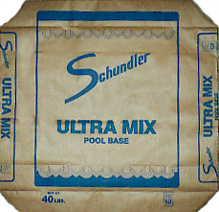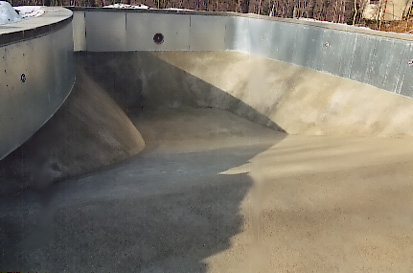WHY ARE VERMICULITE POOL BASES INSTALLED?
Besides being difficult to install, traditional sand bottoms tend to shift and wash away, and sand-cement bottoms can crack and abrade soft vinyl liners. In contrast, vermiculite concrete pool bases offer a smooth, firm, permanent but porous bottom which will not be affected by hydrostatic pressures, water table problems, and constant use.
ADVANTAGES OF SCHUNDLER VERMICULITE POOL BASE BOTTOMS:
- Schundler V+16 Pool Base and Ultra Mix products are made from the best vermiculites available in the world. Vermiculite is a naturally occurring mineral which is non-toxic and non-hazardous. When mixed with portland cement, it becomes a lightweight, insulating concrete which can be troweled to a smooth, permanent pool bottom. It will not shift, slide, rot, decay, or cause the formation of algae.
- When water tables rise and hydrostatic pressures increase, sand bottoms tend to wash out and sand cement bottoms can crack. However, Schundler Vermiculite Pool Bases allow the water to pass through millions of microscopic pores in the vermiculite, and then drain back into the ground when the pressures are reduced.
- Schundler V+16 and Ultra Mix bottoms resist indentations and footprints. If a liner has to be replaced or repaired, the job is easier and less expensive since vermiculite bottoms retain their shape and integrity. Sand bottoms can wash out, and require repacking when repairs and liner replacements are made.
- Vermiculite concrete is an insulating concrete, and so less energy has to be used to maintain comfortable temperatures. In some pools being heated with the same amount of energy, differences of as much as 10 degrees have been reported.
CONSTRUCTION GUIDELINES
WEATHER CONDITIONS AFFECTING VERMICULITE POOL BASES:
Very hot and dry conditions, extremely wet ground or heavy rain, and/or freezing temperatures all create problems when working with any kind of concrete, including vermiculite pool bases:
- On very hot and dry days, the hopper walls and bottom should be misted with water to prevent the water from being sucked out of the concrete too soon and causing premature hydration. Rapid loss of water can cause eventual surface cracking, soft spots, and loss of strength.
-
Very wet conditions can wash out the portland cement reducing or eliminating any strength and eventually resulting in soft spots and the possibility of wash outs.
-
Very cold conditions will slow down curing time significantly. Allow much more time before walking or working on the bottom during very cold weather.
-
Freezing temperatures will prevent vermiculite concrete from curing properly or from ever achieving full strength.
PREPARATION:
A good excavation is very important, if not critical! It will make troweling easier, save time and money, reduce the chances of problems during both installation and the life of the pool! Ideally, the pool will be cut so as to allow exactly 2 inches of vermiculite concrete base.
INGREDIENTS NEEDED:
In order to install a Schundler Vermiculite Pool Base bottom, you will need sufficient quantities of the following:
-
SCHUNDLER V+16 VERMICULITE POOL BASE and
PORTLAND CEMENT (Type I or III, and High Early Cement)
OR, Either
SCHUNDLER ULTRA MIX or SCHUNDLER ULTRA MIX II
(pre-blended mixes of our Vermiculite and Portland Cement)
- Clean water, free from deleterious amounts of acid, alkali and organic matter.
If you are uncertain about how many regular bags of vermiculite or pre-mix you might need, check our approximate coverage charts for different size pools. These are approximate numbers based on several design systems and are based on 2" bottoms.
|
MIXING TECHNIQUES AND FORMULAS:
- When using Schundler V+16 Pool Base and Portland Cement:
- Use: One bag of Portland Cement (94 lbs) two bags of Schundler V+16 Pool Base and approximately 20 gallons of water
- First mix the water and cement. After they are well mixed, then add the schundler v+16 vermiculite, and mix just until the vermiculite is all dampened (often no more than 10-20 seconds and never more than a couple minutes!)
 Ultra Mix
Ultra Mix
|
- When using Schundler Ultra Mix or Schundler Ultra Mix II:
- Use: one bag of Schundler Ultra Mix or Schundler Ultra Mix II and approximately
5-6 gallons of water
- Put water into the mixer first, then add Schundler Ultra Mix and mix just until the vermiculite and Portland cement are damp and wet. Do not over mix!
MIXING TIPS:
- For sloped sections, use a stiffer mix (accomplished by adding less water). The greater the degree of pitch, the stiffer your mix should be.
- Check mixes for these visual characteristics:
- Uniform color
- No dry or unmixed material visible
- Basic "creamy" texture
- Avoid over mixing. Unlike sand concrete, the vermiculite will break down if over mixed. This will suddenly turn the mix very wet and reduce your yield (number of square feet covered by each bag.)
- If possible, use a paddle mixer not a concrete mixer! Concrete mixers are drums or "barrels" with blades welded onto the insides of the drum. When rotated, the material is supposed to "plop" down because of gravity. With vermiculite concrete, there is not enough weight in the material to pull it down and mix it properly. With a paddle mixer, the drum stays stationary and a paddle rotates to mix the material. It mixes faster with more control---and is best for both V+16 and Ultra Mixes.
For information about mixers, go to:
Mixers for Vermiculite Concrete Mixes
 After installing the liner and filling with water,
After installing the liner and filling with water,
the finshed pool!
|
Additional information and tips:
- Use a "pool trowel." These are available from mason supply yards and "diy" stores like home depot. A pool trowel has rounded ends, not square ends, and this makes for much smoother and easier troweling (with a standard trowel, the corner edges often will leave "lines" which are not good and which will be visible if not removed.)
- Try to trowel the vermiculite concrete bottom flat and smooth, but not slick. You do not want a finish which is so smooth that the liner will tend to slip on it, and you do not want to bring so much of the cement fat to the surface that you eventually get surface cracking and crusting.
- If a faster set is desired, or in colder weather, high early cement (Type III) can be substituted for regular Type I cement.
- If the weather has been very hot and dry, the hopper walls and bottom should be slightly moistened before putting down the vermiculite. Hot, dry sandy soil can "suck" the moisture out of the concrete preventing it from curing properly and resulting in dry "crumbly" bottoms.
- If heavy rains are possible, or if the soil is saturated, do not try to trowel a vermiculite concrete bottom. Too much ground water or rain can wash out the portland cement which will result in a soft and mushy bottom.
- If weather conditions drop below 40 degrees, do not try to trowel a concrete bottom. Cold weather can retard the curing process too long, and freezing conditions will ruin and weaken uncured concrete.
- If the excavation left large holes, gouges, or indentations, fill these with vermiculite up to the proper ground level first, and work in other areas of the pool while these areas cure a little. Then layer the final amount of vermiculite concrete necessary to obtain a level surface. Two coats give more strength and are better than one deep and heavy application.
- If a mix has been conveyed into the pool bottom and turns out to be too wet, move on to another area and then return after the mix has dried out a little.
- A vermiculite bottom sets up completely in three to five days. Although in some instances liners can be installed almost immediately after troweling, pool owners should be cautioned about using the pool until curing is complete.
For more information, please call or contact your local dealer or:
The Schundler Company
10 Central Street, Nahant, MA 01908
(ph)732-287-2244
www.schundler.com
email: info@schundler.com
For a .pdf version of this Guide, go to Contractors Guide
Back to Swimming Pool Construction Main Page
Back to Home Page (Main Page of www.schundler.com)



